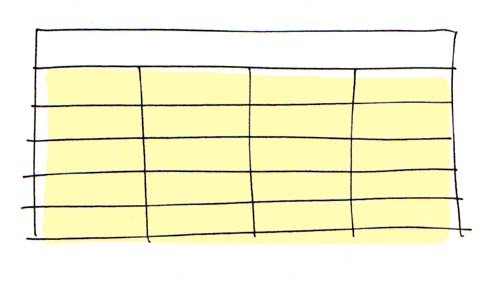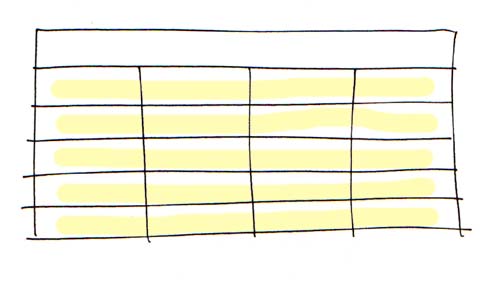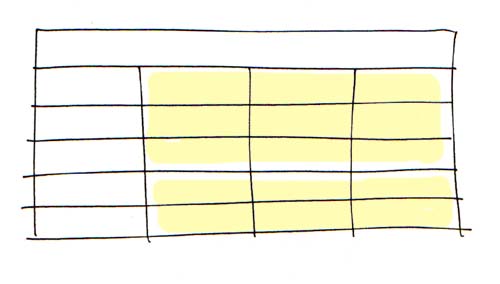
What And How Talk
- http://xpdx.org -- October 1, 2002
Framework for Integrated Test
x p d x
Ward Cunningham
October 1, 2002
Integrated Tests
We desire, and the framework enables, integration at two levels.
- Check facts at every program interface.
- Share facts with every group.
Structured Exploration
Group method based on aligned interests.
- Specification that is as agile as the code.
- All that wonder are not lost.
Let automated tests guide programming.
- Formal supplement to communication
- Written before program works
- Apply to whole system and its parts.
Programmers communicate with code and unit tests.
- Written in programming language
- 100% pass before check-in
- Enables collective ownership
- Enables relentless refactoring
Customers communicate with stories and acceptance tests.
- Written in words and facts
- 100% pass before iteration over
- Shows expectation (simplicity)
- Shows visible progress (confidence)
"Fit" Style Acceptance Tests
- Scrape tables from html docs
- Keep stories & tests together
- Browse results online
| eg.ArithmeticFixture | |||||
| x | y | x + y | x - y | x * y | x / y |
| 200 | 300 | 500 | -100 | 60000 | 0 |
| 400 | 20 | 420 | 380 | 8000 | 20 |
Words and Facts
DataDriven tests embedded in web documents.
- Understandable by everyone
- Examples ground concepts
- Checked against program automatically
Part 1 -- The Specification
Division shall work with positive and negative numbers. http:run.cgi
| eg.Division | ||
| numerator | denominator | quotient() |
| 1000 | 10 | 100.0000 |
| -1000 | 10 | -100.0000 |
| 1000 | 7 | 142.8571 |
| 1000 | .001 | 1000000 |
| 4195835 | 3145729 | 1.3338196 |
Part 2 -- The Fixture
This is how we divide in Java.
class Division extends ColumnFixture {
float numerator;
float denominator;
float quotient() {
return numerator / denominator;
}
}
Reflection to Instantiate Fixture
| eg.Division | ||
| numerator | denominator | quotient() |
class Division extends ColumnFixture { float numerator; float denominator; float quotient() { return numerator / denominator; }
Reflection to Set Fields
| eg.Division | ||
| numerator | denominator | quotient() |
class Division extends ColumnFixture { float numerator; float denominator; float quotient() { return numerator / denominator; }
Reflection to Check Methods
| eg.Division | ||
| numerator | denominator | quotient() |
class Division extends ColumnFixture { float numerator; float denominator; float quotient() { return numerator / denominator; }
Kinds of Fixtures
Experience has shown there to be three kinds of fixtures.
- ColumnFixture -- for logic
- RowFixture -- for result sets
- ActionFixture -- for interaction
Reflects on a single fixture that runs all the cases.

Reflects on domain objects retrieved by the fixture.

Reflects on "screen" fixtures instantiated by the main fixture.

| fit.ActionFixture | ||
| start | eg.music.Browser | |
| enter | library | Source/eg/music/Music.txt |
| check | total songs | 37 |
| enter | select | 1 |
| check | title | Akila |
| check | artist | Toure Kunda |
| enter | select | 2 |
| check | title | American Tango |
| check | artist | Weather Report |
| check | album | Mysterious Traveller |
| check | year | 1974 |
| check | time | 3.70 |
| check | track | 2 of 7 |
Parse nodes correspond to paired tags with surrounding text. Parsing recurses on both body and trailer with results stored in parts and more respectively.
leader <TABLE> body </TABLE> trailer
We can use the same parser to parse application html. http:run.cgi
| fit.ActionFixture | ||
| start | eg.Page | |
| enter | location | http://google.com |
| check | title | |
| enter | link | Jobs |
| check | title | About Google |
| enter | link | Press |
| enter | link | Review |
| check | title | Google Press Room |
This implementation builds on four previous implementations.
- Wyatt Software
- ThoughtWorks
- Role Model Software
- Vulcan
The web site http://fit.c2.com all these examples plus downloads and more documentation.
Return to WelcomeVisitors